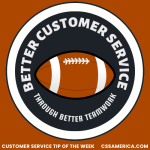
Some of the consulting we perform with clients focuses on ways to be more efficient and to improve quality. Customer service isn’t just about employee attitudes and skills; often customer service is just as much about the processes related to delivering services, responding to needs, and addressing issues.
This type of consulting is part quality improvement, part Kaizen, and part good old fashioned Industrial Engineering (I.E.). So let’s discuss how to apply some of the key principles to the work of an individual – You!
Here are 5 of the 7 Categories of Waste (taken from key lean manufacturing principles) for you to consider. Address these, and maybe your workload decreases, the workflow smooths, and your daily burdens are easier to bear:
- Storage – Find old files (on your computer, in binders, or stuck in those manila folders in your desk), and identify older ones that no longer serve a purpose. Get rid of old files, and put a system in place to purge those periodically so you avoid a never-ending growth of documents.
- Overproduction – In what situations do you produce too many copies of items that go unused? When do you copy more people on e-mails than necessary? When are you copied unnecessarily on e-mails or are sent internal documents that are not needed in hardcopy form? Identify answers to these questions, and look for opportunities to reduce the overproduction.
- Transportation – When do you have to physically change locations – to copy, to meet, to acquire materials or distribute information? Become more productive by finding ways to spend less time simply transporting from Point A to Point B.
- Waiting – When are you idle? Okay – maybe never. But when can you not go on to the next steps because you’re waiting on a co-worker, a customer, a process, or a system to do its thing? This wastes your time, and it also causes you to have even more projects or initiatives underway at once – that creates more plates for you to keep spinning at the same time. Identify the waits, and find ways to eliminate them.
- Correction – When do you have to correct the work of others – or vise-versa? When you do have to fight customer fires caused by the wrong information, wrong product, or wrong response being delivered? These issues waste your time and often the time of your customer. Use these questions to identify these causes of costly poor quality.
You probably are getting the hang of this exercise now. The final 2 Categories of Waste are Motion and Processing. Apply this approach to the other 2 Categories, coming up with questions and the answers that highlight time wasters.
Then – as with the others – use the answers to begin moving toward solutions to reduce your hassles and save yourself time.
Eliminate the waste, and make your days just a little bit better.
Signup for FREE Tips! Contact Us More Resources for You Visit Our Home Page























